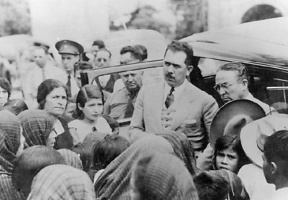MEXICAN INDEPENDENCE DAY SPECIAL ISSUE
By Daniel Nardini
 One other important thing Cardenas did to stabilize the country was to make sure that all commanding officers swore an oath to the Mexican Constitution. By doing this he brought the armed forces under the executive branch and made sure that all officer were appointed by the president and approved by the Congress. Since that time, the Mexican army has never again interfered with the institutions of the country, and since then the armed forces have always been a subordinate part of the government instead of being an independent force. To break the corruption endemic in the system since the Mexican Revolution, Cardenas closed down all of the gambling parlors and brothels that had brought incredible wealth to many of Callas’ former cronies and broke the power of organized crime. Demonstrating his fearlessness, Cardenas traveled by car throughout the country and even on horseback instead of by armored car with a retinue of military security to show that he wanted to meet the people. Even with the possibility of assassination, Cardenas did not waiver in presenting himself to the public.
One other important thing Cardenas did to stabilize the country was to make sure that all commanding officers swore an oath to the Mexican Constitution. By doing this he brought the armed forces under the executive branch and made sure that all officer were appointed by the president and approved by the Congress. Since that time, the Mexican army has never again interfered with the institutions of the country, and since then the armed forces have always been a subordinate part of the government instead of being an independent force. To break the corruption endemic in the system since the Mexican Revolution, Cardenas closed down all of the gambling parlors and brothels that had brought incredible wealth to many of Callas’ former cronies and broke the power of organized crime. Demonstrating his fearlessness, Cardenas traveled by car throughout the country and even on horseback instead of by armored car with a retinue of military security to show that he wanted to meet the people. Even with the possibility of assassination, Cardenas did not waiver in presenting himself to the public.
Cardenas created the Department of Indigenous Affairs. The purpose of this department was to protect and encourage the languages and cultural institutions of Mexico’s indigenous people who had been for the most part neglected since Mexico became independent. Equally, Cardenas tried to make peace with the Catholic Church. Under Callas’ presidency, anti-church and anti-clerical laws had been passed in an attempt to diminish the influence of the Church in Mexico. The result had been the Cristero War where Mexican troops had fought against Catholic rebels—with very bloody results. Cardenas distanced himself from his predecessor’s policies while allowing the Catholic Church to re-open religious schools that had been shuttered during the Cristero War. He ended capital punishment (which has remained true to this day in Mexico’s penal code), and he provided refuge to those Spanish nationals fleeing Spain when the Nationalists under dictator Francisco Franco took over the country and destroyed the Spanish Republic in 1939.
As an important gesture, Cardenas named a non-military candidate Manuel Avila Camacho to succeed him in the election of 1940. When Camacho was elected, Cardenas retired, never again to seek the presidency and certainly not to run the country again from his “retirement” as had been true of past presidents. In fact, Cardenas was the only president at the time who did not become wealthy after becoming the head of state, and he retired to a modest home in his native Michoacan. From 1942 to 1945 he was Mexico’s Minister of War, but that was the last office he ever held, and for the rest of his life he worked on irrigation projects as well as building medical clinics and schools for the poor. Even though Cardenas was part of the one party rule that would dominate Mexico until 2000, he tried to make the government as clean, organized and representative of the people as best he could. For this, Lazaro Cardenas is fondly remembered to this day as being one of Mexico’s greatest presidents.


 New Illinois laws in Effect on July 1, 2025 July 3, 2025
New Illinois laws in Effect on July 1, 2025 July 3, 2025 ComEd, HIRE360 Celebrate New Graduates July 3, 2025
ComEd, HIRE360 Celebrate New Graduates July 3, 2025 ComEd Kicks Off Elk Grove Substation Expansion July 3, 2025
ComEd Kicks Off Elk Grove Substation Expansion July 3, 2025







The Lazaro Cardenas Revolution, Part II
MEXICAN INDEPENDENCE DAY SPECIAL ISSUE
By Daniel Nardini
Cardenas created the Department of Indigenous Affairs. The purpose of this department was to protect and encourage the languages and cultural institutions of Mexico’s indigenous people who had been for the most part neglected since Mexico became independent. Equally, Cardenas tried to make peace with the Catholic Church. Under Callas’ presidency, anti-church and anti-clerical laws had been passed in an attempt to diminish the influence of the Church in Mexico. The result had been the Cristero War where Mexican troops had fought against Catholic rebels—with very bloody results. Cardenas distanced himself from his predecessor’s policies while allowing the Catholic Church to re-open religious schools that had been shuttered during the Cristero War. He ended capital punishment (which has remained true to this day in Mexico’s penal code), and he provided refuge to those Spanish nationals fleeing Spain when the Nationalists under dictator Francisco Franco took over the country and destroyed the Spanish Republic in 1939.
As an important gesture, Cardenas named a non-military candidate Manuel Avila Camacho to succeed him in the election of 1940. When Camacho was elected, Cardenas retired, never again to seek the presidency and certainly not to run the country again from his “retirement” as had been true of past presidents. In fact, Cardenas was the only president at the time who did not become wealthy after becoming the head of state, and he retired to a modest home in his native Michoacan. From 1942 to 1945 he was Mexico’s Minister of War, but that was the last office he ever held, and for the rest of his life he worked on irrigation projects as well as building medical clinics and schools for the poor. Even though Cardenas was part of the one party rule that would dominate Mexico until 2000, he tried to make the government as clean, organized and representative of the people as best he could. For this, Lazaro Cardenas is fondly remembered to this day as being one of Mexico’s greatest presidents.